The BURAN orbiter is the first reusable manned space vehicle in our
country. The BURAN orbiter is the space airplane which may descent from an orbit and land to an airdrome. The BURAN is our first vehicle capable not
only to put pay-loads into Space, but also to provide their orbit maintenance and repair
as well as return to the Earth.
| The BURAN predecessors could execute only separate roles: VOSTOK and SOYUS vehicles were intended only for crew flights, PROGRESS - for
cargo delivery onto the orbital station. Put into the orbit by a rocket carrier of the
average size they had modest transport potentials. Whereas the cargo flow on the
Earth-orbit line increased and the development of a reusable vehicles of large carrying
capacity has become inevitable. |
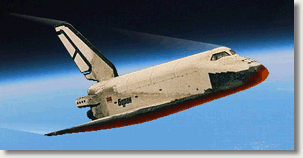 |
| The BURAN orbiter is able to put up to 30 tons into Space and to
return up to 20 tons of payload to the Earth. The availability of a cargo
compartment of impressive sizes on the vehicle permits to transport orbital station
modules or large structures up to 17 m long and 4,5 m in diameter and not only 2-4 crew members but up to 6 passengers can be accommodated in a crew cabin. |
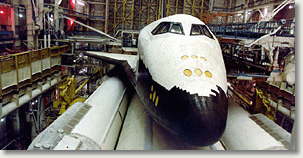 |
| Expendable space vehicles perform a ballistic or
sliding descent in the atmosphere and parachute landing. The necessity to provide a space
vehicle return from the Space and to bring it to the airdrome forced the designers to
decide many complex problems. The gliding descent from the orbit through
dense layers of atmosphere has stipulated the necessity to use a principally new reusable thermal protection system designed to sustain 100 flights. For the
BURAN orbiter three kinds of thermal protection have been developed: |
| - |
"carbon-carbon" material with
maximum operating temperature up to 1650 degrees C for the components with the highest
thermal load -the fuselage nose and wing leading edge, |
| - |
ceramic tiles for parts heating up to 1250
degrees C, |
| - |
flexible material for surface parts with
the temperature not higher than 379 degrees C. |
All of them
surpassed by strength the materials used in the USA Space Shuttle construction. |
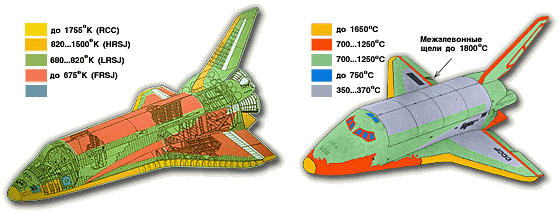 |
| USA Space Shuttle |
 |
BURAN orbiter |
|
Each of almost forty thousand tiles of ceramic thermal protection had
its original geometry differing from the others by plane form, side surfaces view and
inside and outside surfaces curvature, availability of cuts and notches.
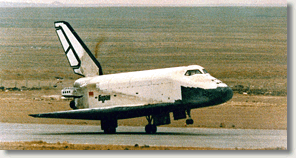 |
The measurements of a real frame surface geometry
under each tile in more than 100 points were made to ensure the tiles fitting closely. To
execute all this manually was impossible. The special software was developed and as a
result form building, manufacturing and installation of tiles were carried out completely
on paperless technology without drawings and templates, using the bank data. The bank data
is based on the interface between a design office and plants. The data bank information
describtes the geometry, technology parameters and materials. More than one billion
manufacturing control and testing programmes are automatically generated on the plant. |
| The BURAN descending from a space orbit passes all possible for an
airplane flight performances in the atmosphere starting with large hypersonic (M-25) up to
landing (M=0,2) speeds. In this connection the aerodynamic scheme without a horizontal
tail with a double swept wing, with elevons, rudder-aerodynamic brake and balance flap as
control surfaces has been chosen. This assembly has been worked up during wind tunnel
tests and evaluated in the BOR-5 suborbital flying model
flights. |
 |
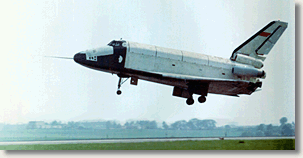 |
For working up the most responsible flight phase -
landing approach and landing - the BURAN flying prototype was
constructed. In general it distinguished from the orbital vehicle by installation of four
turbojet engines and accordingly by capability of an independent takeoff from the
airfield. 24 flights were executed on the prototype, in 15 of them completely automatic
mode landing was made. |
| There was no pilot onboard the orbiter but it having made two turns
around the Earth completely automatically controlled touched the runway with the accuracy
which experienced pilots could envy. It was the first in the world automatic landing of a
spaceplane. The SPACE SHUTTLE defaults it so far. |
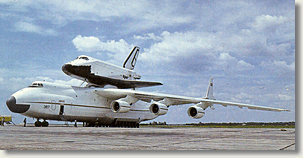 |
The BURAN orbiter flight was a necessary step in the space
engineering progress but it has left its trace not only in this field. Born in the course
of work on the BURAN project new materials, technologies, computer designing methods and
equipment components find an application in far, at first sight, from Space branches of
economy.
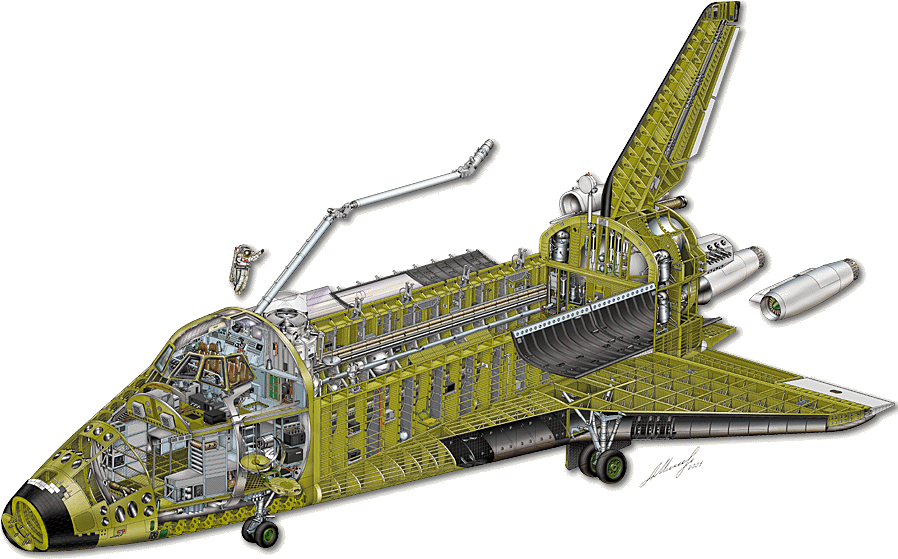

We are glad to introduce the last (2.0 release) version of Buran orbiter 3D
'roentgen' sketch.
| The main differences between
the space aeroplane Buran and Suttle-orbiter are follows: |
| - |
the automatic landing of Buran from orbit onto airdrome; |
| - |
the absence ot the main rocket engine on the orbital aeroplane. The
main engine was placed onto a central block of a carrier-rocket ENERGIA which is able to
launch into an orbit 120 tonns of payload against 30 tonns for Space Shuttle; |
| - |
the hight lift-drag ratio of the space aeroplane Buran is 6.5 against
5.5 for Space Shuttle; |
| - |
the space aeroplane Buran returned 20 tonns of payloads against 15
tonns for Space Shuttle orbiter from an orbit to an aerodrome; |
| - |
the cutting lay-out pattern of thermoprotection tiles of Buran is
optimal and longitudinal slits of tile belts are orthogonal to the flow line. Sharp angles
of tiles are absent. The tile belts of the Buran fuselage and fin have an optimal
position. |
|
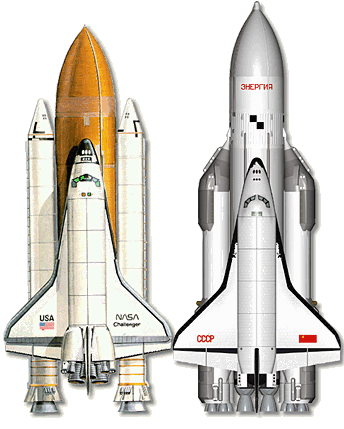 |
 |
More detailed
information may be found in selected chapters from Aerospace Systems:
Book of Technical Papers under edition of G.E.Lozino-Lozinsky
and A.G.Bratukhin. - Moscow: Publishing House of Moscow Aviation Institute, 1997. - 416
pp., ill.: - "Strategy
and Prospect of Development of Reusable Space Transport Systems" by Dr. Lozino-Lozinsky G.E.;
CREATION AIRFRAME OF THE
BURAN ORBITAL SPACESHIP
- "Creation of the BURAN Spaceship - One
of Important Technological Problems of the Aviation Industry" by Dr. Bratukhin
A.G.;
- "The NPO MOLNIYA Experimental Plant. Main Direction of
Activity" by Bashilov A.S.;
- "Tushinsky Machine-Building Plant" by Zverev
N.K., Arutyunov S.G.;
- "Development of Configuration of the Orbital Spaceship"
by Ushakov V.M.;
- "Main Aspects of Aerodynamic Designing the BURAN
Orbital Spaceship" by Naboishchikov G.F. (and full Russian
COLOR Version);
- "Trajectories of BURAN Orbiter's Descent and
Landing Algorithms of the Automatic Guidance and Control" by Dr. Kirpisñhikov
V.P. (and full Russian COLOR Version);
- "Guidance and Control of Orbital Plane"
by Trufakin V.A.;
- "The Full-Scale Stand of the Equipment and the
Piloting-Dynamic Training Stand" by Nekrasov O.N.;
- "Simulation on the Piloting-Research Complex in the
Cosmonaut Training Center" by Gorbatenko V.V, Shurov A.I., Vaskov A.S.;
- "BURAN Orbiter Horizontal Flight Tests"
by General Mikoyan S.A.;
- "BURAN with a Crew on Board" by Bachurin I.I.;
- "Problems and Way of Creation of the Automatic Landing
Complex" by Balashov M.P.;
- "Structure of the BURAN Orbiter" by
Dr. Tarasov A.T.;
- "The Doors of the Payload Bay of the BURAN Orbital
Spaceship" by Stepanov A.P.;
- "Metal Materials in a the Structure of the
BURAN Spaceship's Airtrame" by Sergeev K.N., Shalin R.E., Bulgakova S.G.;
- "Non-Metallic Structural Materials of the BURAN
Orbital Spaceship" by Gutman I.P., Kulikova G.V.;
- "Non-Metallic Materials in the BURAN Orbital Spaceship"
by Vulfovich L.V., Kurochka G.M.;
- "Automated Technology of Assembly-Welding of the BURAN
Spaceship Cocpit" by Ryazantsev V.I., Kovyazina S.I.;
-"Thermal Designing of the BURAN Orbital
Spaceship" by Voinov L.P.;
-"Design and Experimental Development of the BURAN
Thermal Protection" by Timoshenko V.P.;
-"The Heat Protection Structure of the Reusable Orbital
Spaceship" by Dr. Gofin M.Ya.;
- "Technology for Continuous Structures of Discrete
Quartz Fibre" by Prilepsky V.N.;
- "Automated Systems of Designing, Mathematical
Modeling and Manufacturing for the BURAN Orbital Spaceship" by Osin M.I.;
- "Gas Dynamic Non-Stationary Loads on the BURAN Orbital
Spaceship" by Rozanov I.G.;
- "Strength of the BURAN Orbital Spaceship's Structure"
by Dr. Tarasov A.T.;
- "Main Directions of Technology Development at Creation
of the BURAN Spaceship" by Podkolsin V.G., Chernousov V.N.;
- "Technological Preparation to Manufacturing the BURAN
Spaceship" by Chernousov V.N.;
- "Technology of the Indestructible Check and
Technical Diagnostics of the BURAN Orbital Spaceship" by Konnov V.V.;
- "Methods and Means of the Pressurization Check for the
BURAN Structure" by Chernousov V.N.;
- "Radio-Navigational Maintenance of the Atmospheric
Descent and Landing of the BURAN Orbital Spaceship" by Shcharensky V.A.;
- "The Information Display System of Information and
Control for the BURAN Reusable Orbital Spaceship" by Mushkarev Yu.G.;
- "The Control of the Onboard Complex of
Equipment" by Karimov A.G.;
- "The Electrical Distribution and Switching System"
by Kornilov V.A.;
- "Ensuring Electromagnetic Compatibility of the BURAN
Equipment" by Kornilov V.A.;
- "Features of the Antennas Installation on the BURAN
Orbital Spaceship" by Kornilov V.A.;
- "Auxiliary Power Plant of the Orbital Spaceship"
by Saenko V.I.;
- "Hydraulic System and Drives" by Fomin
N.L.;
-"Cabin" by Dr. Fedotov V.A., Novikov
V.K. (pictures for this chapter);
- "Ensuring Reliability and Safety of the BURAN
Orbital Spaceship" by Chaly B.V., Yarigin Yu.N.;
-"Air Transportation" by Dr. Fedotov V.A. (and full Russian COLOR Version);
- "Landing Complex for the BURAN Orbital
Spaceship" by Yakhno V.A., Studnev V.V.;
- "Experimental Development of the BURAN Orbital
Spaceship" by Shabanov V.K.;
- "Conversion of the Aerospace Technologies
Assists NPO MOLNIYA to Survive and Return to Space" by Dr. Gofin M.Ya.;
FROM SPIRAL TO MAKS
- "Analysis of Various Concepts of the
Reusable Space Transportat Systems" by Dr. Dudar E.N.;
- "Horizontal Take-off Two-Stage Aerospace Transport
Systems" by Kutyakin E.P.;
- "The SPIRAL Orbital Plane and the BOR-4 and BOR-5
Flying Models" by General Mikoyan S.A.;
- "The MAKS Multipurpose Aerospace System" by
Skorodelov V.A.;
- "The MAKS-D Experimental Aerospace System"
by Skorodelov V.A.;
- "Thermal Designing of the Orbital Planes"
by Voinov L.P.;
- "Gas Dynamic and Thermal Designing of the
Aerospace Planes" by Sokolov V.E.;
- "The MAKS Orbital Plane's Wing Deflection as a
Means of the Aerodynamic Optimization on All Modes of the Flight" by Terekhin
V.A.;
- "The MAKS Flight Performance" by Dudar
E.N., Lobzova T.A.;
- "Features of the MAKS Structure" by
Dr. Tarasov A.T.;
- "Metal Materials for the Advanced Aerospace Systems"
by Sergeev K.N., Bulgakova S.G.;
- "Advanced Non-Metallic Materials for the
Cryogenic Aerospace Structures" by Vulfovich L.V., Kurochka G.M.;
- "Features of the Information Provision of the
Aerospace System" by Risenberg V.H.;
- "The MAKS Onboard Starting Complex" by
Mushkarev Yu.G.;
- "The MAKS Onboard Control Complex" by
Balashov M.P., Gordiyko S.V., Karimov A.G.;
- "Main Principles of the MAKS Control
Organization" by Nekrasov O.N., Korovin K.G.;
- "Missions of the Aerospace Systems" by
Tsarev V.A.;
- "Technical-Economic Investigations on the Efficiency
of Reusable Aerospace Systems" by Kosinsky Yu.M.;
- "The Tri-plane Aircraft as the Means of the MAKS
Efficiency Improvement" by Dr. Lozino-Lozinsky G.E.;
- "Technical Inventions in the NPO MOLNIYA" by
Gusinsky I.I.;
- "Scientific Potential of the NPO MOLNIYA"
by Fedotov V.A. |
Our Photogallery:

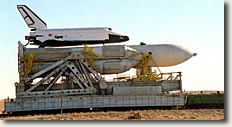
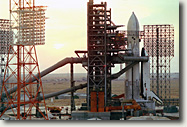

 and more,
more...
and more,
more...
Our Videogallery:
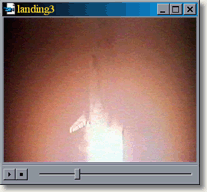
start2.avi, 320x260,
3.97Mb, 34sec. |

landing5.avi, 720x576,
3.12Mb, 33sec. |

landing4.avi, 320x260,
1.85Mb, 34sec. |
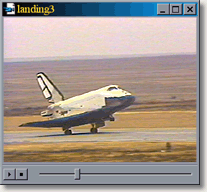
landing.avi, 720x576,
4.84Mb, 45sec. |
and more, more... |
Our CD-ROMs:
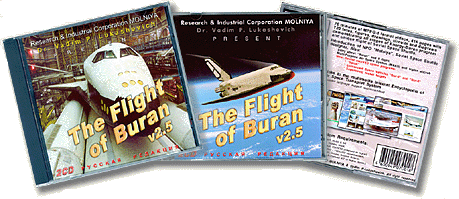

Web-master: ©Vadim Lukashevich 1998-2006
E-mail: buran@buran.ru



![]()














